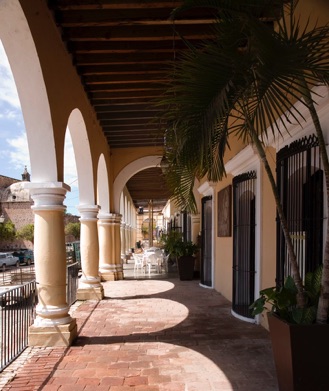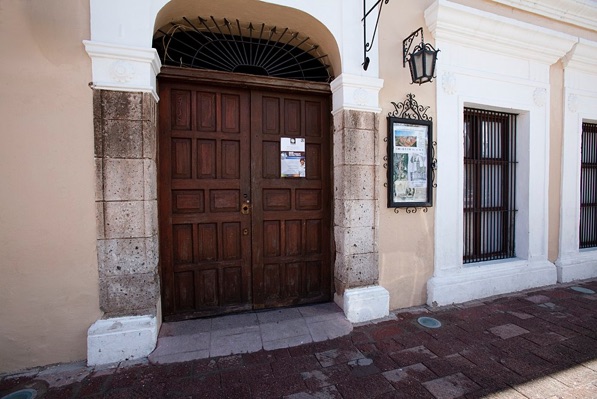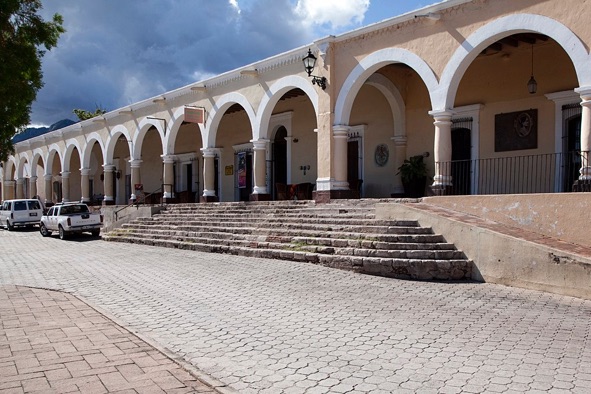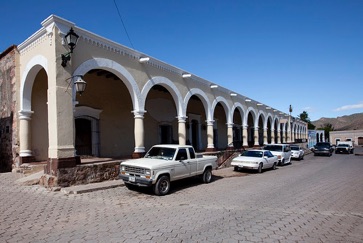Álamos Historic Buildings



Iglesia Parroquía de Nuestra Señora de la Purísima Concepcíon
The church sacristy holds church records dating back to 1690, written in India ink on handmade paper. When Franciscan Friar Antonio de los Reyes came to New Spain in the 18th Century as Bishop of Sonora, Sinaloa and the Californias, the Álamos church was a small adobe building. The bishop ordered that it be rebuilt as a cathedral, and construction began in 1786. Built with three domes and stone walls five feet thick, its gold altar pieces were imbedded with precious stones–but these valuables were stolen or destroyed during revolutions and Indian uprising. The bells and clock on the outside wall were sent from Spain.


The Robinson Bours House
This house originally belonged to Bartolomé Salido, who operated a bank from this building while he lived at Madero #9 across the street. Salido gave this building to Ignacio Almada, his daughter’s husband, when they married in the 1830s. Locally called the Robinson Bours house, the building was donated to the Catholic Church and became a convent school for young women and for religious retreats until two years ago, when it was remodeled and renamed the “Nelita Bours Community Center.” The house now serves the Álamos community as a meeting center.



The monastery and home office of the Missionaries of Fatima, together with adjoining buildings were originally built by General Anselmo Macías, governor of Sonora from 1939 - 1943. It was operated by the family as a hotel, then donated to the Diocese of Obregón after Gen. Macías death in 1965. The eight-acre property has housing units, a communal dining room, a chapel, living spaces for priests and seminarians, and offices. The property also includes an orchard of fruit trees, part of which is used by a local resident as a pasture for his sheep. Numerous plants and flowers adorn the property, located less than a five-minute walk from the Plaza de Armas and the historic la Parroquia de la Purísima Concepción cathedral.

Monastery, Missionaries of Fátima




Hotel Los Portales

Callé Juárez #6 is the Hotel Los Portales, a portion of the home built by Don José María Almada in the early years of the19th Century. Don José, owner of the two richest mines in northern Mexico, had 19 children with his first wife, Isabela; after her death in the 1840s, he had 14 more children with his second wife. The property fell into ruin until 1947 when Levant Alcorn, an American visiting this city, purchased the property and started the “Álamos Revival” which continutes to this day.



Escuela Bartolomé Salido
The building which now houses Bartolomé Escuela Primaria on Calle Guitérrez was the former home of Don Bartolomé M. Salido, and it was in this house where Bishop Antonio de los Reyes and his nephew were entertained upon their arrival in Álamos in 1783. With stone walls and a large courtyard, it was a typical 18th Century mansion. Upon the death of the last Salido heir, the building was willed to the municipal government for the establishment of a school in honor of the Salido family.

The Silk Factory
The building directly behind the church encompasses a full block, and is now divided into two private residences and the El Nicho gift shop. It was originally owned by Plutarco Gómez de Lamadrid and built in the early 19th Century when the Gómez de Lamadrid family was one of the Álamos “elite.” Correspondence involving this family and others in Álamos from 1854 - 1933 can be found in the “Rosenda Gómez de Gómez Lamadrid” collection at the University of Arizona.
In the late 19th Century this building housed a silk factory, owned by a Japanese family. Sra. Hortensia Vega Navarrette writes in a History Association interview (The Vega Family) of working in the factory during the early 1940s; while there were mulberry trees, she said no silkworms were on them—the silk thread was shipped in.
After the factory closed, the building was restored by Paul Robinson and later became three separate residences.







The Bishop’s Palace
The Bishop’s Palace at #8 Comercio was part of a city-block building erected in the 18th Century by the Álvarez family and given to Bishop Antonio de los Reyes when he arrived in Álamos in the 1780s. The building today includes a number of residences, including the Nuzum House at #2 Comercio (left) which Pember and Elizabeth Nuzum bought and restored in 1969.
The Bishop’s house was also the residence of Mercedes Almada, the mistress and later second wife of Don José María Almada. It was Mercedes who had the second floor placed on the house (rumored to be because the Almada family home had two floors!), and the ceiling above the formal dining room is 30 feet above the tiled floor.





El Museo Costumbriste de Sonora

The house at #1 Calle Victoria, El Museo Costumbriste de Sonora, was owned by Sr. Adolfo Bley as a mercería, a store filled with mining equipment and household goods.
The son of an American from the Confederate South who fled the U.S. after the civil war, Bley lived in the building on Calle Cárdenas north of his store. He had two grand pianos in this house, and two of his carriages are on display in the patio of the museum. In 1914, when the town was in financial ruin, Bley closed the doors at #1 Calle Victoria. When the property was donated to the city as a museum in 1983, it was just as it had been left when Sr. Bley locked the doors nearly 70 years before.




la Casa de los Tesoros
Built in 1787 by Fr. Juan Nicolás Quierós, the parish priest, it served as his residence for the next 60 years. Upon his death it was willed to Don Joaquín Urrea, and in the next century it became first a school and later, according to legend, a convent.º Ortilia Urrea de Figueroa, whose remembrances are a part of the “Álamos Inteviews” section of this website, tells of attending the first grade in 1903 in what is now Room #10 of the Casa de los Tesoros.
Americans Al and Darly Gordon bought the building in the 1950s as a ruin and turned it into a hotel and restaurant. Darly Gordon expected guests to make reservations and be dressed appropriately (jackets for men!), and for several decades it was a spot favored by foreign visitors to Álamos. The hotel is currently owned by Suzanne Chartrand.
ºÁlamos historian Juan Carlos Holguín Balderrama has found no verification, however, that the Tesoros was ever a convent. See “Myths in Álamos History” on this website.


The Álmada House

Hotel los Portales covers only a portion of the space
where José María Almada and his wife, Isabela, once lived. The building had crystal chandeliers made in Belgium, oriental rugs, and tableware and dishes made of silver.


All Photos©Errol Zimmerman
All Photos©Errol Zimmerman
All Photos©Errol Zimmerman
All Photos©Errol Zimmerman

GO TO:
Álamos Historic Photo Exhibit
https://alamoshistoryassociation.org/50.63.41.1/Alamos_Historic_Photo_Exhibit.html
Alamos, Sonora, has more than 180 structures designated by the
government for their historical importance, and ten of these can be viewed on this page. A History Association Project is underway to photograph the exteriors and interiors of all 180 historical buildings and place these images on the website.
